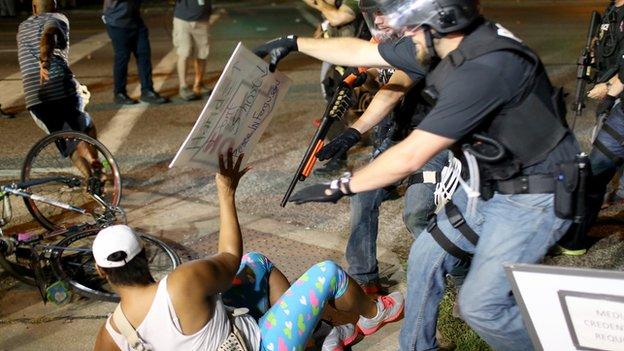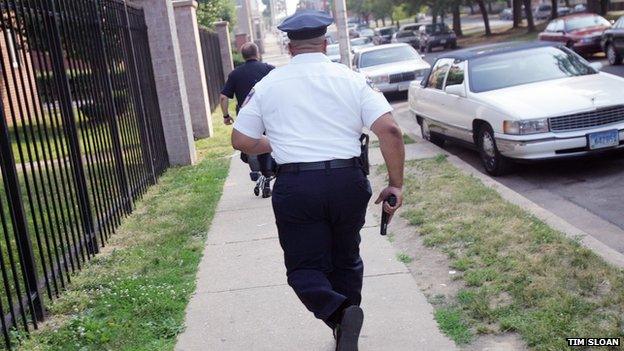Death by cop: Invisible numbers
- Published
- comments

The protestors of Ferguson, Missouri, may be gradually leaving the streets following weeks of marching in the name of Michael Brown, an unarmed black teenager who was shot and killed by police, but critical questions remain.
One, in particular, seems to have no good answer. How many other Americans are shot and killed by law enforcement each year?
The US lacks a standardised process to track police killings across the nation's 17,000 law enforcement agencies, which ultimately paints an incomplete portrait of police use of force.
According to the Federal Bureau of Investigation's annual Supplementary Homicide Report, there have been about 400 "justifiable police homicides" each year since 2008. The Centers for Disease Control and Prevention and the Bureau of Justice Statistics have reported similar numbers.
These estimates may be wrong, however, writes, external Reuben Fischer-Baum a staff writer for the website FiveThirtyEight. "Efforts to keep track of 'justifiable police homicides' are beset by systemic problems."
For instance, a rather significant issue with the data is that it is self-reported. The FBI program that tallies "justifiable police homicides" depends on state and local police agencies to submit their own statistics.
Additionally, there is no official tracking of police killings that, while conducted in the line of duty, were not justified. So if Officer Darren Wilson were found to be at fault for Mr Brown's death, it would not be included in the official FBI statistics.
The lack of comprehensive data is likely not intentional, write, external the Urban Institute's John Roman and Zach McDade in the Huffington Post.
"It's extremely time-consuming for police to record the facts of every incident, and police departments simply lack those resources," they say.
Reno News & Review reporter D Brian Burghart counters that it's too convenient for government officials to say they are unable to produce data that could embarrass to law enforcement.
"No government - not the federal government, and not the thousands of municipalities that give their police forces license to use deadly force - wants you to know how many people it kills and why," he writes, external in an opinion piece for Gawker.

Crime writer Jim Fisher says there were at least 607 fatal police shootings in 2011
He says he's spent the last two years trying to compile information on police shooting, and he has been obstructed every step of the way.
As the technical prowess of police departments increases, however, calls for better data collection and analysis likely will grow.
"This data-driven society, in which retailers know the buying habits of their customers down to the last dollar and police use sophisticated software to target crime 'hot spots', apparently lacks solid and systematic information about police shootings," write, external the Washington Post's editors.
"Right now, the United States is embroiled in a necessary, but at times emotional, debate about the use of deadly force by police against civilians. Precise, complete and reliable official information must inform that discussion."
Not only do the police lack the resources to conduct comprehensive data collection, police shooting data, like other crime data, are "notoriously problematic" and prone to underreporting, says, external Richard Florida, editor of the Atlantic magazine's CityLab website and research professor at New York University.
"The prospect of the state killing its own people is a very serious one," writes Florida. "And the US must mandate reporting of all such incidents, collecting and publishing detailed accounts of how, why and when these killings have occurred."
In fact, 20 years ago the US attempted to mandate a standardised data collection process.
As part of the Violent Crime Control and Law Enforcement Act of 1994, Congress required the US attorney general to gather statistics on excessive force by police and publish an annual report of the data.
But the act was somewhat vague about the details of the annual report, writes Michael Doyle for McClatchy, "including the definition of excessive force". Ultimately the Justice Department failed to produce the required reports.
In response to the lack of data, some people have developed new methods to find a more accurate total number of police shootings.
In 2011 crime writer Jim Fisher did an independent online news search, external each day for reports of police-involved shootings. Over the course of a year, he counted 1,146 police-involved shootings, 607 of them fatal.
Taking a page from Fisher's playbook, Deadspin writer Kyle Wagner has recently attempted, external a crowd-sourced approach to tallying police-involved shootings between 2011 - 2013. The final results have not yet been tabulated.
FiveThirtyEight's Reuben Fischer-Baum, using news reports compiled Facebook users on the privately run page Killed by Police, external, estimates the number of fatalities to be around 1,000 a year.
Reason magazine writer/producer Anthony Fisher says, external that considering how much data the US government takes from its citizens, it is "outrageous" that the press and public must struggle to recover important statistics like police shootings.
"Deadspin's efforts at providing transparency on police shootings are a great example of public volunteerism stepping up to fill a void deliberately created by the government, which would rather not have this conversation," writes Fisher.
(By Annie Waldman)